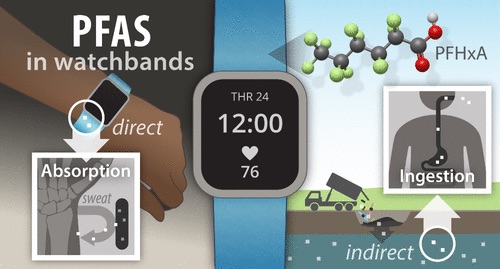Wearable technology like smartwatches and fitness trackers has become a staple of modern life. They promise to help you track your health, improve fitness, and keep your goals on track—all conveniently strapped to your wrist. But what if your trusty wearable is quietly undermining your well-being? A 2024 study by researchers at the University of Notre Dame has revealed that many smartwatch bands contain alarmingly high levels of toxic per- and poly-fluoroalkyl substances (PFAS), also known as “forever chemicals.” Add electromagnetic fields (EMFs) into the mix, and suddenly, these health gadgets don’t seem quite so healthy anymore.
The study highlights the widespread use of PFAS in smartwatch bands, especially in fluoroelastomers, synthetic rubbers prized for their durability and resistance to sweat. While these materials make for sleek, easy-to-clean bands, they come with a hefty health price tag. These chemicals, which are absorbed through the skin, are linked to cancer, hormonal disruptions, and more. It’s time to uncover the risks lurking in wearable tech.
What Are PFAS and Why Are They Dangerous?
PFAS are a group of over 15,000 synthetic chemicals designed for their water-resistant, stain-resistant, and heat-resistant properties. They’re often found in non-stick cookware, waterproof clothing, and firefighting foams. But here’s the kicker: they’re called “forever chemicals” because they don’t break down naturally, persisting in the environment and accumulating in your body over time.
The health risks associated with PFAS exposure are well-documented. Long-term exposure has been linked to cancer, including kidney, liver, and testicular cancers. PFAS can also suppress the immune system, leaving you more vulnerable to infections and illnesses. As endocrine disruptors, these chemicals wreak havoc on your hormones, which can mess with your metabolism, energy levels, and overall well-being. They’ve also been linked to liver and kidney damage and developmental issues in children and fetuses. So, while you’re tracking your steps, your smartwatch band might be feeding your body a steady diet of toxins.
The Study That Blew the Whistle
Researchers at the University of Notre Dame conducted a deep dive into smartwatch and fitness tracker bands, and the results were anything but reassuring. Out of 22 tested bands, 15 contained significant amounts of PFAS, those notorious “forever chemicals.” The study used high-tech methods like particle-induced gamma-ray emission spectroscopy and liquid chromatography-mass spectrometry (LC-MS/MS) to reveal how widespread these chemicals are in wearable devices.
Key Findings from the Study:
1. PFHxA Dominates the Scene
The most commonly found PFAS compound was perfluorohexanoic acid (PFHxA), with concentrations as high as 16,662 nanograms per gram (ng/g). PFHxA is linked to liver damage and is more mobile in the environment, making it a widespread contaminant.
2. PFOA Makes a Troubling Appearance
Some bands also contained perfluorooctanoic acid (PFOA), a chemical so toxic that the EPA has declared no safe level of exposure in drinking water.
3. Skin Absorption Risks
Research has shown that up to 60% of certain PFAS compounds can be absorbed through the skin. For smartwatch wearers, the combination of sweat, heat, and friction opens the door for these toxins to seep directly into the bloodstream.
4. Fluoroelastomers Aren’t Your Friends
Many bands are made from fluoroelastomers, synthetic rubbers marketed for their durability and sweat resistance. Unfortunately, they’re also loaded with PFAS, making them a hidden health hazard.
Perhaps the most alarming revelation is how closely PFAS levels in some smartwatch bands resemble those found in firefighting gear. Firefighting gear is designed to withstand extreme environments where exposure to dangerous chemicals is expected. Your smartwatch, however, is supposed to track your steps, not pump toxic compounds into your skin.
The Lack of Transparency
The study also called out the wearable tech industry for its lack of transparency. Many brands use terms like “fluoroelastomer” without explaining that these materials are often laced with PFAS. Consumers are left in the dark, unknowingly exposing themselves to dangerous chemicals every time they strap on a smartwatch.
PFAS in Everyday Life: A Broader Look
The problem with PFAS isn’t limited to your smartwatch band—they’re everywhere. Another 2024 study published in Environmental International paints a bleak picture of just how pervasive these chemicals are. From cosmetics to food packaging, PFAS have wormed their way into nearly every aspect of modern life.
How PFAS Spread:
1. Airborne Particles
PFAS don’t just stay put in the products they’re used in. They can become airborne, settling on surfaces and entering our bodies through inhalation or ingestion. This means your living room, office, and even the gym could be a hotspot for PFAS exposure.
2. Water and Food Contamination
PFAS leach into water supplies and agricultural systems, contaminating everything from drinking water to the food we eat. Short-chain PFAS, like PFHxA, are particularly problematic because they spread quickly through water and are difficult to remove.
The Trouble with Short-Chain PFAS
Short-chain PFAS were initially introduced as a “safer alternative” to long-chain PFAS. However, research has shown that they’re just as toxic and even harder to contain. Their increased mobility in water and air makes them nearly impossible to escape, leading to widespread contamination and chronic exposure.
Cumulative Exposure Matters
PFAS build up in the body over time. Even small, consistent exposures from multiple sources can create a significant toxic burden. For smartwatch users, wearing a PFAS-laden band every day adds to the load your body has to handle, making it harder to stay healthy.
By understanding how PFAS infiltrate our lives, we can start making informed decisions to limit our exposure. These chemicals might be unavoidable, but we can certainly reduce our interaction with them—starting with the products we choose to wear.
Now that we’ve covered how PFAS affect your body, let’s dive into another hidden threat in smartwatchesthat’s just as sneaky and maybe even more harmful: electromagnetic fields (EMFs).
How EMFs Add to the Toxic Load of Wearables
Let’s talk about electromagnetic fields, or EMFs—the invisible buzz of radiation that comes with every connected gadget. If PFAS weren’t bad enough, your smartwatch is also pumping out EMFs from Bluetooth, WiFi, and even cellular connections. While these aren’t the same as the harmful rays you’d get from standing in front of an X-ray machine, they’re far from harmless.
The real issue? EMFs have been linked to increased oxidative stress in the body, which is a fancy way of saying they ramp up the free radicals that damage your cells. This leads to inflammation, a slower recovery process, and even long-term health problems. And if you thought they stopped there, think again:
- Oxidative Stress: EMFs crank up the production of free radicals, damaging your cells and tissues.
- Melatonin Suppression: Want restful, healing sleep? EMFs say “no thanks” by reducing your melatonin production, leaving you tired and under-recovered.
- Hormonal Disruption: Both PFAS and EMFs love messing with your hormones, creating a double whammy of endocrine chaos.
- Blood-Brain Barrier Vulnerability: Studies show EMF exposure can weaken the blood-brain barrier, the shield that protects your brain from harmful substances. When this barrier is compromised, toxins—including PFAS—can more easily enter the brain, potentially contributing to neuroinflammation and cognitive decline.
- Gut Health Disruption: EMFs don’t just affect your brain—they also mess with your gut. Research has linked EMFs to disruptions in the gut microbiome, the community of bacteria that supports digestion, immunity, and mental health. A damaged microbiome can lead to leaky gut syndrome, inflammation, and a cascade of other health issues.
What makes this worse is that devices with cellular connectivity, like certain smartwatch models, emit higher levels of EMFs. Constantly communicating with nearby cell towers means your device is working overtime—and so is your body, trying to cope with the radiation. Wear it 24/7, and you’re essentially letting your smartwatch call the shots on your health.
Practical Steps to Protect Yourself from PFAS and EMF Risks
Balancing your health with the convenience of wearable tech requires a proactive approach. Here are some practical ways to minimize your exposure to both PFAS and EMFs:
1. Switch to Safer Materials
Opt for silicone or PFAS-free bands for your wearable devices. These options are both durable and comfortable, free from harmful chemicals often found in traditional materials.
2. Limit Wear Time
Reduce the time you spend wearing devices by removing them when not actively tracking your health. Every break gives your body time to recover from potential EMF exposure.
3. Use Airplane Mode
When real-time syncing isn’t necessary, activate Airplane Mode to disable wireless connectivity like Wi-Fi and Bluetooth. This simple change drastically lowers EMF emissions.
4. Clean Your Bands Regularly
Use water and non-toxic soap to clean your bands frequently. This helps remove surface chemical residues, keeping your skin healthier and reducing exposure to potential toxins.
5. Practice Grounding
Discharge EMF buildup in your body by walking barefoot on natural surfaces like grass, sand, or soil. Grounding is a simple yet effective way to rebalance your body’s natural energy.
6. Prioritize Health-Conscious Tech and Materials
Opt for bands made of silicone or other PFAS-free materials. These options are durable, comfortable, and free from harmful chemicals commonly found in traditional bands.
- Choose low-EMF devices like the Oura Ring for health tracking or use EMF-neutralizing tools like Aires Tech’s Lifetune Go or Lifetune Flex to reduce oxidative stress and inflammation caused by EMFs.
In Summary
Your smartwatch might be smarter than you think—but not in a good way. Between the toxic PFAS lurking in its band and the EMFs radiating into your body, this so-called health tool could be undermining your well-being. By making informed choices and taking proactive steps to minimize exposure, you can enjoy the benefits of wearable tech without compromising your health. In the quest for a healthier you, don’t let your gadgets get in the way.



















